Michael Collins was killed, but where, exactly?
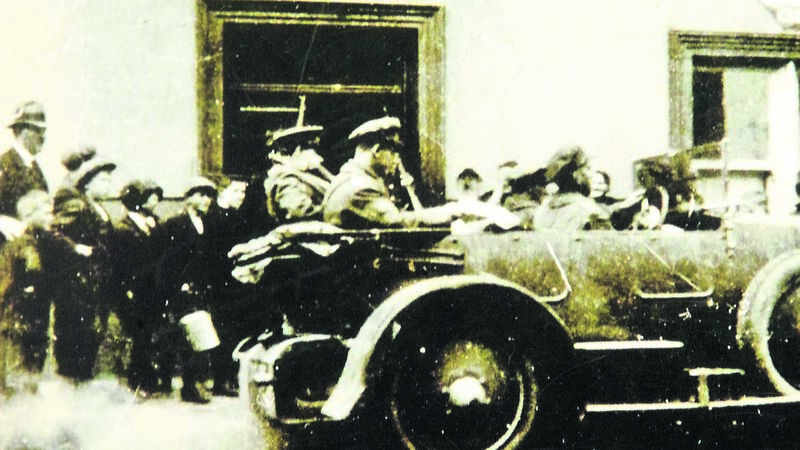
Pictured seated at the rear of the open top car was Michael Collins before leaving Bandon to travel to Beal Na Blath. Picture Denis Boyle
MICHAEL Collins was cranky. The affable and avuncular revolutionary leader, the ‘Laughing Boy’ of countless Dublin old women, was like a bear with a sore head.
Collins was the ‘world’s worst patient’. Miserable with a summer cold that had ‘gone to his chest’, the fighting in Dublin against his old comrades who were implacably opposed to the Anglo-Irish Treaty did nothing to alleviate his grumpiness.
Now, as he prepared to leave the capital on a tour of inspection of national army posts in the south, a comrade who watched him from a nearby window thought he looked like ‘The loneliest man in the world’.
In the grey, half-light of that August morning, he observed Collins, all alone in the barrack yard, racked with pain. The forlorn figure with an army knapsack on his back looked like a child waiting to start his first day at school.
The thought that the inspection, involving many hundreds of miles, was to be undertaken in an open ‘touring’ car, with a driver unfamiliar with the unmetalled minor roads — every bump and pothole would be felt — did nothing for the ‘Big Fella’s’ tetchiness.
Arriving at the Imperial Hotel on Cork City’s South Mall in the early hours of Tuesday, August 22, exhausted after a busy day of meetings, Collins was incensed to see the two sentries, supposed to be alert in a still dangerous city, asleep.
Without a word, he banged their heads together, no doubt managing an inward chuckle, and carried on to his room. As he lay on the bed, he reflected on the events of the day. Everywhere he went, it seemed, he was received with open arms.
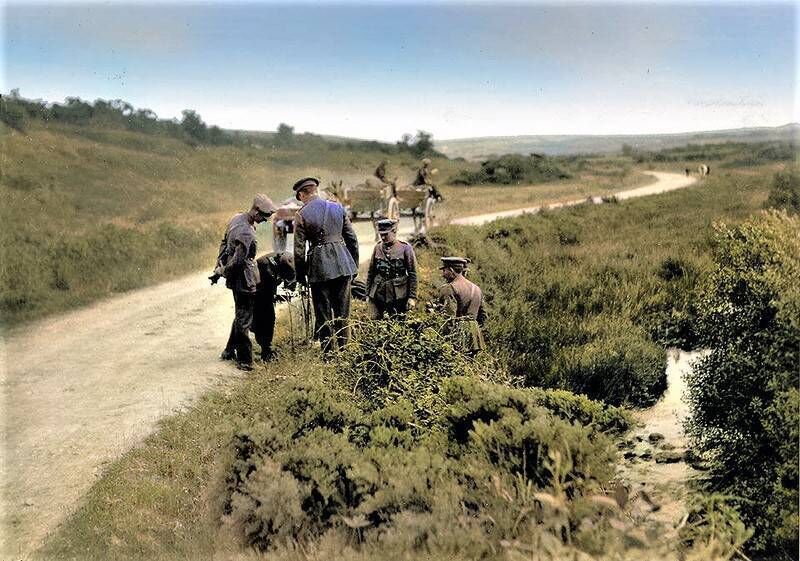
“The people are splendid,” he confided to his diary.
Shortly after 6am, in company with 24-year old Major General Emmet Dalton, the senior ranking officer of ‘Cork command’, a convoy of vehicles, comprised of the Leyland touring car, a Rolls-Royce Whippet armoured car (the Sliabh na mBan: Most national armoured vehicles had been named), a Crossley tender full of enlisted soldiers, and a motorcycle out-rider, left the Imperial Hotel, ostensibly on a tour of army outposts in West Cork.
But Collins had his own, secret, agenda, which, to the chagrin of historians ever since, he did not commit to paper. If his trip had merely been an inspection, it could have been postponed, because of his fever. However, he had confided to his brother, Johnny, that his trip to Cork would involve meeting leaders on the anti-Treaty side, as well as those who formerly held high office in the national movement but had decided against taking sides in the current conflict.
And, before leaving Dublin, a confidante recalled how, “He slapped one fist into his hand and said, ‘That fixes it! The three Toms – Tom Malone, Tom Barry, and Tom Hales will fix it’.”
He intended meeting with those men to bring about a speedy end to the Civil War, which he detested.
The little convoy roared off up the South Mall, through Washington St and out the Western Road, for its appointment with destiny.
Within 24 hours, the news was flashed around the world that Collins, the young, charismatic leader of the new Ireland, had been felled by an Irish bullet in an obscure place in Co Cork called ‘Béal na mBláth’. But was it ‘Béal na mBláth’?
Townlands are the smallest official unit of administration in Ireland, followed by the parish. Our townlands are ancient divisions, and some have existed under other names since pre-Christian times. By the early 1800s, local taxes were based on the valuation of townland units.
These valuations were informed by hopelessly obsolete information and poor mapping, and it became necessary for the boundaries of townlands to be mapped to provide a framework for new valuations. There are 64,000 townlands in Ireland, so the scale of the undertaking can be imagined.
In the 1800s, the British prime minister, the Dublin-born Duke of Wellington, authorised the first ordnance survey of these islands, beginning with Ireland.
If successful, the template would be rolled out across Britain. The task was given to Lieutenant Colonel Thomas Colby and a staff from the royal engineers, with civil assistants.
Colby issued detailed instructions on the treatment of place names. For example, the correct orthography — the conventional spelling system of a language — of the names of places was to be entered into a name book as it was locally spelt and the modern modes of spelling it were to be inserted in a second column.
In 1830, John O’Donovan, from Kilkenny, joined the staff of the Topographical Department of the Ordnance Survey. Educated at Hunt’s Academy, Waterford, he would establish himself as an Irish-language scholar of renown.
His interpretation of the seven-volume Annals of the Four Masters is widely regarded as his magnum opus.
Michael Collins isn’t the only tetchy one in our short story. 75 years before the ‘Big Fella’s name would be for ever associated with the place where he fell, O’Donovan had written to his superiors in exasperation.
He was unhappy about being tasked with providing translations in English of Cork placenames. He had not previously worked in the county and was not au fait with the nuances of Irish pronunciations there.
“In consequence,” he wrote, “of not having the local Irish pronunciation of the Cork names, they are vexing me very much. Indeed, it is hardly fair to ask me to venture explaining them at all without visiting the localities.”
Vexed or not, he had a job of work to do and, with some reservations, he did it. The name ‘Bealnabla Bridge’ first appears in the parish namebook of the ordnance survey for 1842.
The namebook carries John O’Donovan’s initials near the recommended form of the name for the six-inch OS map. ‘Bealnabla Bridge’ remained on the six-inch map until 1901, with the remapping to the scale of 25 inches.
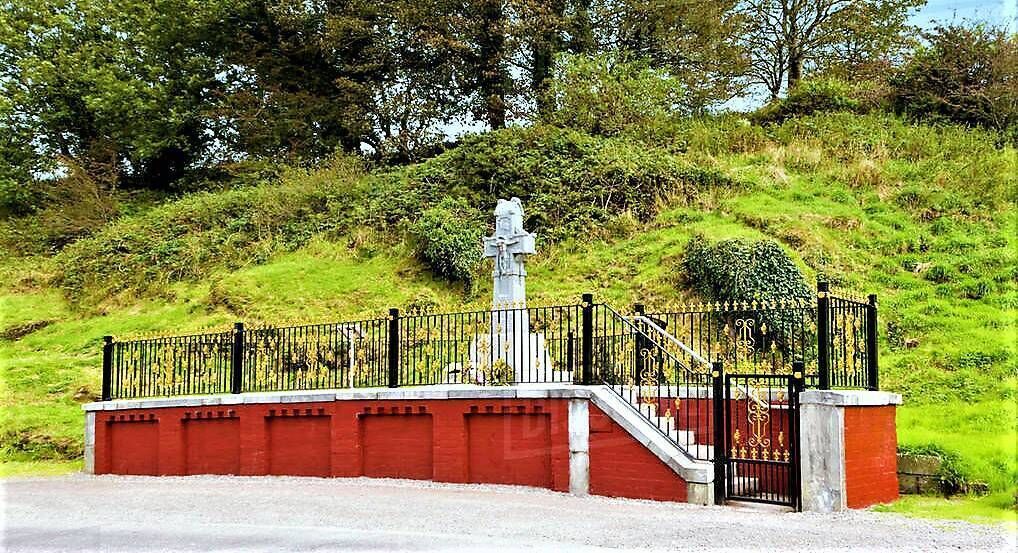
The new namebook survey, begun in 1897, refers to the appellation as being ‘obsolete’ and is replaced with ‘Bealnablath’. This form appears again on the one-inch OS map of 1906. In neither case were síne fadas employed. The place itself is somewhat of an enigma, with the original version of the name becoming obscured with time.
Over the years, scholars have wrestled with the conundrum, with myriad proposals being put forward as possible contenders, including: 1, Béal Átha na Bláiche (‘Mouth of the Ford of the Buttermilk’); 2, Beal Atha Nabla (‘Mouth of Mable’s Ford’); 3, Béal na Blá (‘Mouth of the Plain’). This refers to the dominant topographical feature of the area; the two-and-a-half mile-long ravine through which the River Bride flows from Béal na Blá village down to Crookstown and onwards to the flatlands of the lower Bride Valley; 4 Béal na mBláth (‘Mouth of the Flowers’).
The latter version is now widely used but, as purists point out, does not accord with the pronunciation used by the last native Irish-language speakers in the area, who survived until the 1940s. This form seems to have been seized upon by one or more of the English journalists who descended on Cork in the aftermath of Collins’s death.
‘The Mouth of the Flowers’ had a certain romantic ring to it, as befitting the death place of a great Irish chieftain: A latter-day Cúchulainn’s Clochfearmore. A ‘Mouth of the Ford of the Buttermilk’ just wouldn’t have the same cachet. Most Irish newspapers reporting on the events of the August 22, 1922 refer to the place as Bealnablath.
The Irish Placenames Commission regards Béal na Blá as the most accurate rendering of the original placename: Béal na Bláth is listed as a local name.
******
On the evening of Tuesday, August 22, 1922, all of this was academic, as the commander-in-chief of the Irish army and his little convoy entered the valley on their way back to the city after a long day of inspections in West Cork. A light drizzle had begun to fall and hung over the place like a depressing spell.
Since that time, various commentators, including Beaslaí, O’Connor, Taylor, Neeson, Forester, Ryan, Twohig, Dwyer, and Coogan — to name but a few — have written about what happened next, each with his/her own particular emphasis as to the sequence of events.
The following is extracted from Major General Dalton’s report on the encounter, and Dalton was seated next to Collins in the car:
“It was about a quarter past seven and the light was falling.
Our motorcyclist scout was about 50 yards in front of the Crossley tender, which we followed at the same interval in the touring car, and close behind us came the armoured car.
“We had just reached a part of the road that was covered by hills on all sides. On the right we were flanked by steep hills; on the left of the road there was a small, 2ft bank of earth skirting the road.
“Beyond this, there was a marshy field bounded by a small stream and covered by another steep hill.
“About halfway up this hill there was a road running parallel to the one we were on, but screened from view by a wall, and a number of trees and bushes. We had just turned a wide corner on the road when a heavy fusillade of machine-gun and rifle fire swept the road in front of us and behind us, shattering the windscreen of our car.
“I shouted to the driver, ‘Drive like Hell!’, but the commander-in-chief, placing his hand on his shoulder, said, ‘Stop! Jump out, we will fight them!’ We jumped from the car and took what cover we could behind the little mud bank on the left side of the road. It appeared the greatest volume of fire was coming from the concealed roadway on our left-hand side.
“The armoured car backed up the road and opened a heavy machine-gun fire at the ambushers. General Collins, I, and another officer, Joe Dolan, who was near us, opened fire on our seldom-seen enemies, with rifles.
“We continued this firefight for about 20 minutes without suffering any casualties, when a lull in the enemy’s fire became noticeable. General Collins jumped to his feet and walked over behind the armoured car, obviously to obtain a better view of our enemy’s position. He remained there, firing occasional shots, using the car as cover.
“Suddenly, I heard him shout, ‘There they are, running up the road!’ I immediately concentrated on two figures that came in to view on the opposite road.
“When I next turned around, the commander-in-chief had left the car position and had run about 15 yards back up the road, dropped into the prone firing position, and opened up on our retreating enemies.
“A few minutes had elapsed when the officer in charge of our escort came running up the road under fire, and dropped into position beside me and said, ‘They have retreated from in front of us and the obstacle [a farmer’s dray] is removed. Where’s the Big Fella?’ I said, ‘He’s all right. He has gone a few yards up the road, I hear him firing away’.
“Then, I heard a faint cry, ‘Emmet, I’m hit!’ The two of us rushed to the spot, fear clutching our hearts. We found our beloved chief and friend lying motionless in a firing position, firmly gripping his rifle, upon which his head was resting.
“There was a gaping wound at the base of his skull, behind his right ear. We immediately saw that he was almost beyond human aid. He did not speak. With my heart torn with sorrow and despair… I gently raised his head on my knee and tried to bandage the wound… and I had not completed my sorrowful task when his eyes quietly closed, and the cold pallor of death covered his face.
“How can I describe the feelings that were mine, kneeling in the mud of a country road with the still-bleeding head of the idol of Ireland resting in my arms? Having transferred the body of our chief to the armoured car, where I sat with his head resting on my shoulder, our sorrowful little party set out for Cork.”
Minute details of the ambush aside, when all was said and done only one material fact remained: Michael Collins, described by Tom Barry as the man who made the greatest contribution to the fight for Irish independence, was dead.
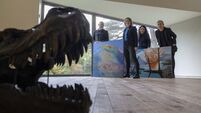
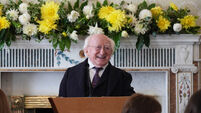

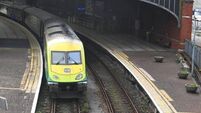
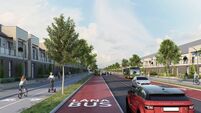
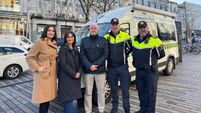
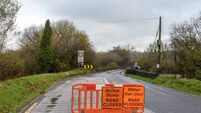



 App?
App?





